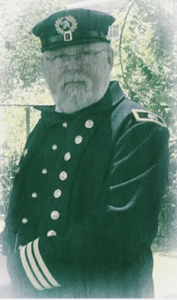
Rodgers, a son of the famous Commodore John Rodgers, was born near Havre de Grace, Maryland. He received his appointment as a midshipman in the Navy on April 18, 1828. Service in the Mediterranean on board Constellation and Concord opened his long career of distinguished service, and he commanded an expedition of Naval Infantry and Marines in Florida during the Seminole Wars. In the mid-1850s he succeeded Commander Ringgold in command of the North Pacific Exploring and Surveying Expedition, which added greatly to the knowledge of far eastern and northern waters.[1] Following his promotion to Commander in 1855, he married and settled to work in the Navy’s Japan Office in Washington, D.C., where he was serving when the Civil War broke out. He was 48 years old.
Commander Rodgers’ first war assignment was to go with Commodore Louis M. Goldsborough to Gosport Navy Yard on April 20, 1861, where with other officers he was to remove Naval vessels and assets so they could not be used by the Confederates. Virginia had only just declared her secession from the Union. Upon arrival they found the yard in shambles, as Commodore McCauley had already ordered the vessels at Gosport scuttled, including the Merrimack, since he considered the yard indefensible. Commodore Goldsborough made the decision to destroy the yard, and Commander Rodgers and Army Captain of Engineers Horatio G. Wright were given the job of destroying the drydock. They were thwarted in this attempt when the fuse was extinguished by water in the pumping gallery. Commander Rodgers and Captain Wright were captured by General William B. Taliaferro of the Virginia State Militia, but since Virginia had not yet joined the Confederate States, and was therefore not at war against the United States, Governor John Letcher returned the two officers to Washington.
Commander Rodgers was then sent to the Western Rivers, where he organized the Western Flotilla and supervised construction of the City Class Gunboats, the first ironclad gunboats on the western rivers. He was relieved by Captain Andrew Hull Foote, a more senior officer being required by the Navy to deal with the prickly Major General John C. Fremont. After blockading operations off of Savannah in command of the Flag, he assumed command of the experimental ironclad Galena in April 1862, operating with distinction in the James River. He commanded the James River Flotilla, including the USS Galena, the ironclad Monitor, and the 90-day gunboat Aroostook in an expedition up the James River in May 1862, which was stopped eight miles shy of Richmond by Confederate fortifications at Drewry’s Bluff. The damage that the Galena suffered in the ensuing battle caused him to report, “We demonstrated that she is not shotproof”, and made him disdainful of trying experiments in the fires of war. Thereafter he supported General McClellan‘s Peninsula Campaign with Naval bombardment, preventing Confederate forces from overrunning the Army of the Potomac‘s position.
John Rodgers was promoted to Captain July 16, 1862 and took command of the ironclad monitor Weehawken. After successfully navigating her from Brooklyn to Charleston through the same storm that sank the USS Monitor, he distinguished himself during the attack on Fort Sumter in May 1863, and in capturing the Confederate ram Atlanta on June 17, 1863.
Michael R. Sanders
Michael is a native Californian, relocated to Virginia courtesy of the US Army. After graduation from high school, he enlisted as a Fire Direction Specialist for the Artillery, serving in Germany with an 8 inch howitzer battalion.

He then reclassified as a Forward Observer, seeing a change of his station to Fort Ord in Monterey, CA. After 4 years in combat arms, with interest in computers, he then trained as a computer operator and was then assigned to the US Military Academy at West Point, NY. While there, he transitioned to become a programmer/analyst. With a further assignment in Stuttgart, Germany for three years and a final assignment at the Pentagon, his total time in service was just over 14 years. Michael left the service and began a 10 year stretch as a civilian contractor, finally taking employment with the federal government as a transportation analyst with the Surface Transportation Board in Washington, DC in 1997, which is where he still works today.
Michael has always had an interest in acting, starting when he was in high school, thru his time with the Army in community theater productions. When he left the Army, he began performing in renaissance fairs. He found a love of acting also gave him an opportunity to also enjoy history. He has since portrayed Sir Henry Sidney of Queen Elizabeth I’s court, King Henry the Eighth, Captain Edward Smith of RMS Titanic and now Captain John Rodgers of the Passaic-class ironclad monitor, USS Weehawken.
Michael Sanders can be contacted at john.rodgers@uniongenerals.org.